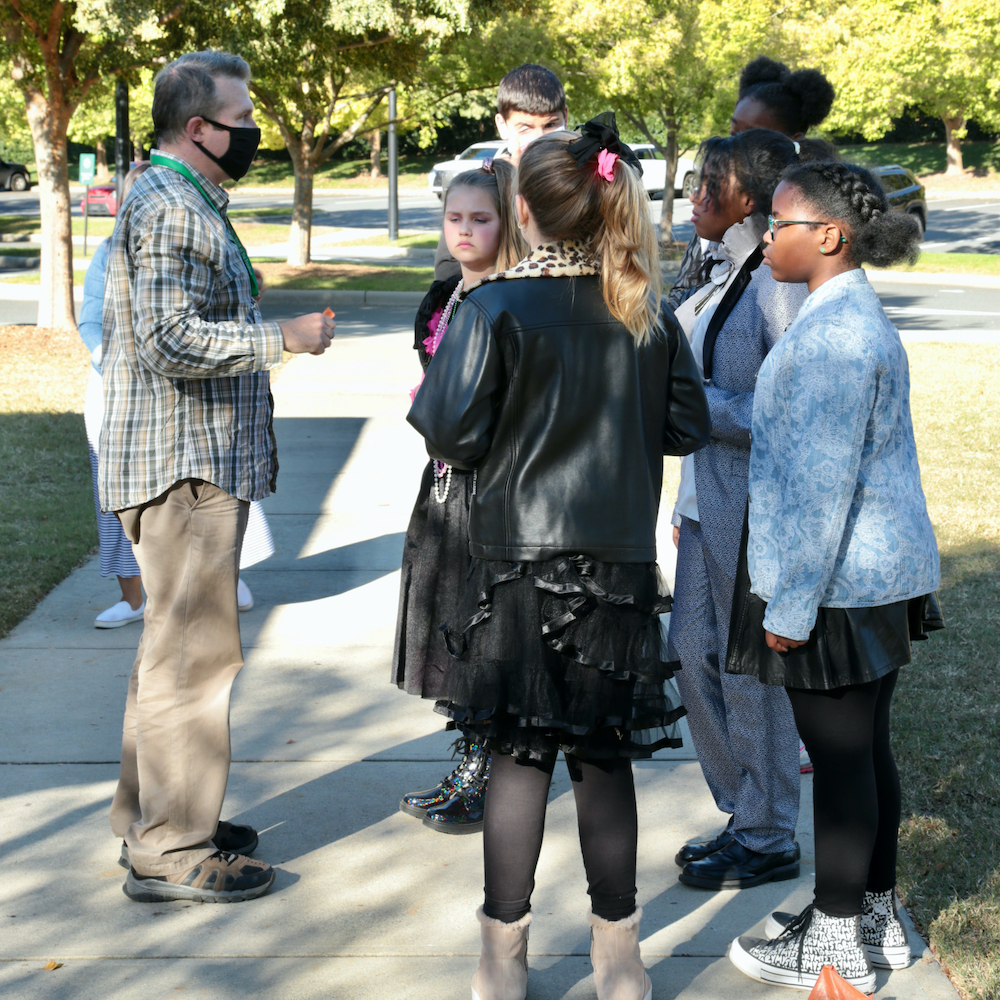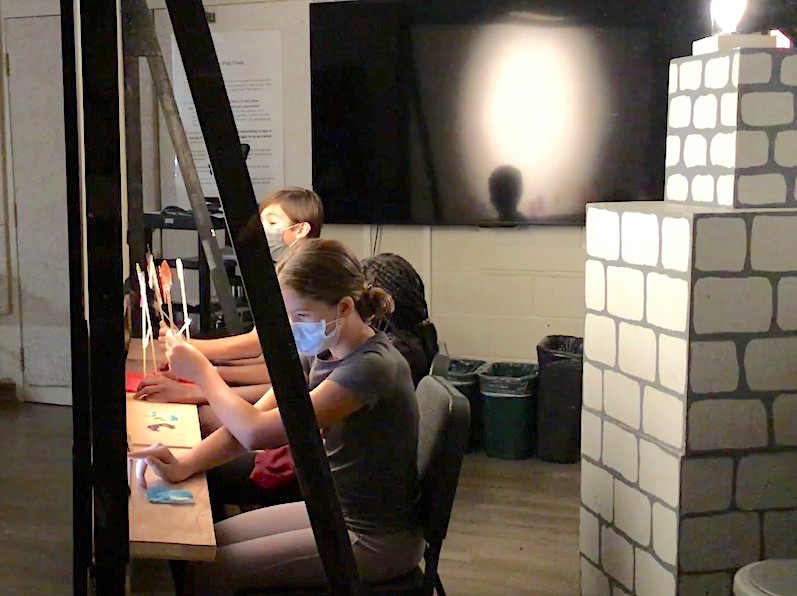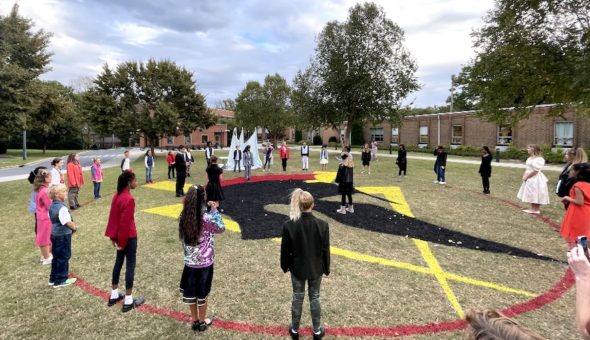Engaging Students in Middle School Theater
By Kasey Short

When designing curriculum, Aaron consistently includes social and emotional skills, diverse texts, multicultural arts, and interdisciplinary connections in his unit plans.
When I asked him about his motivations, he explained that his hope is to make theater accessible to young people by making connections to their day-to-day lives and studies, giving students a platform to stretch themselves creatively, see the similarities and celebrate the differences of theatrical performance from different regions, countries, and cultures – all while letting the world around them inform their story.”
Shadow Puppetry Folktales
This unit incorporates diverse texts, Asian culture and traditions, history, visual arts, writing, interpreting texts, collaboration, design, performance, and endless opportunities for creative and critical thinking.
Students first learn how Chinese shadow puppetry is used to pass down stories between generations. They then explore how puppets are used for storytelling and the different styles of puppets. After reading various folk tales for Asian cultures, they work in groups to modify a folktale by creating characters and a script that represents their own version of the story.
Students complete character analysis questions to help them organize their ideas and think deeply about their characters. Once groups write their scripts with stage directions and dialogue, they begin creating their own shadow puppets from sheet plastic, cardstock paper and dowel rods. Students then explore various methods for creating puppets and spend time creating the visual art representation of their imagined characters.
They then rehearse using the puppets behind a screen to act out their story and finally perform their folktale for their peers. Throughout the project students practice collaborating with their groups, working together to combine everyone’s ideas into a working script, and providing thoughtful feedback to their peers to create the best possible performance.
Monologue Performance
After selecting a monologue for their performance, students complete a deep character analysis of the character they will portray. Through this analysis students practice various English Language Arts and social and emotional skills by examining a character’s feelings, objectives, and thoughts based on their dialogue and making connections between themselves and the character.
The questions below help students critically examine their character and the complex nature of human emotions, wants, needs, and actions.
● What do you know about the character?
● How is the character like you and different than you?
● Would you react the same way the character did to their situation? Why or why not?
● How do the words the character says impact others?
● What does the character desire?
● What is the character afraid of?
● What is the character’s goal and what is stopping them from achieving the goal?
● What emotions is the character feeling? What words/phrases specifically show their feelings?
After examining the character and studying the monologue, students then write journal entries from the perspective of the character with the goal that they consider the character’s thoughts, feelings and overarching objective, and then write from their perspective.
Before performing, students record themselves practicing their monologue and then are given memorization tricks to help build their confidence and prepare them to share their monologues live in front of their peers.
Devising
This technique uses improvisation to help students practice their playwriting skills and create scenes and monologues that represent something important to their lives.
Students work as a class to choose a broad topic significant to them for their skits. This year students chose to focus on the anxiety and pressure they feel related to grades, friendships, sports, etc. They then work with a partner to create an outline of a scene with a situation and characters.

Aaron Mize with theater students
Then students workshop their outlined moment using improvisation and incorporating ideas from the audience and teacher to discover new ways for their characters to interact. This activity helps them develop ideas for their scene while learning social and emotional skills by reacting to unexpected situations, collaborating, interpreting body language and tone, making decisions, and building confidence.
While they are acting, their teacher records them so that they will have a record of their great ideas. Then they use their improv to help write a more formal script.
Song in a Box
This project asks students to analyze and make personal connections to song lyrics and then create a physical representation of those emotions, themes, and ideas in a box.
Students choose a pop song that is appropriate for school and meaningful to them. Then they research the lyrics of the song and identify words of the song that illustrate the mood and themes of that song using action and descriptive words. After they identify those words, they compile a list of potential elements of design (line, shape, color, texture) and principles of design (proportion, balance, rhythm, unit, emphasis) that embody the theme and mood of the song.
Before creating their box, they write an essay that explains the following questions:
● Why is the song important to you?
● How do you feel when you listen to the song?
● What colors, lines, and images best represent these feelings?
● How will you use theme, mood, and feelings from the song to inspire the imagery in the box design?
Students then complete a visual arts representation of their song in a box.
Questions to encourage critical thinking in theater
● Do you think theater can be used to address major social topics? Why or why not?
● Do you think theater can be used to create social change?
● What techniques do directors use to connect audience members to the story and/or characters?
● How has theater changed over time?
● How are new voices of Broadway impacting the art and craft of theater? Consider plays such as Hamilton and In the Heights.
● How does changing costumes, scenery, and/or lighting impact a production?
● If plays are written to be performed, can they truly be understood from reading alone?
● Is Shakespeare still relevant to audience’s today?
Theater Production
Simultaneous to the work he puts into being a classroom teacher, Aaron Mize seeks plays for after-school productions that have diverse characters, themes, and stories including A Wind of a Thousand Tales, Myth Adventures, and The Flying Prince.
He also has found innovative ways throughout the pandemic to provide students with opportunities to perform for live and virtual audiences. He directed War of the Worlds as radio drama in the fall of 2020. All students were masked, and the production was recorded for a virtual audience.
In the spring of 2021 he directed the musical Shrek Jr. and worked through the challenge of having rehearsals and the final production outside. In the fall of 2021 he directed Myth Adventures where students performed in small groups outside and the audience traveled from one performance to the next in different outside locations on the school grounds.
Student Voices
✻ “Mr. Mize sees strengths within me, I don’t see myself. He encourages me to step outside my comfort zone by performing skits, singing, and dancing in front of my peers, until I am confident. Everything he has taught me, will help me throughout life and in every aspect of school, from speeches, writing, and even sports. Mr. Mize makes sure that the character inside me comes to life. I am forever grateful for the time he puts in to make sure I have the opportunity to succeed. In life, I hope I inspire as many people as he has.” – Addi
✻ “Mr. Mize has taught me so much in my 4 years with him. Not just about theater and acting, but also how to work with my classmates, and build confidence. One of my favorite things about him is how he teaches my peers and I to not be afraid to go out of our comfort zones.” – Cassie
✻ “I know that Mr. Mize has changed my life, and many others, for the better. He sees no flaws in any person, only different, unique, and amazing traits that make them who they are.” – Sarah
Resource: Although this NPR post focuses on plays for high school it offers a comprehensive database that’s worth browsing!
Kasey Short (@shortisweet3) loves to share ideas from her classroom and writes frequently for MiddleWeb. She attended the University of North Carolina at Chapel Hill and earned a bachelor of arts in middle school education with a concentration in English and history. She went on to earn a master’s in curriculum and instruction from Winthrop University. She is currently an eighth grade ELA teacher and English Department chair at Charlotte (NC) Country Day School.

































Oh my goodness, we need more Mr. Mize’s for our kids! What an inspiring article! Thanks for including the comments from his students. Just WOW!